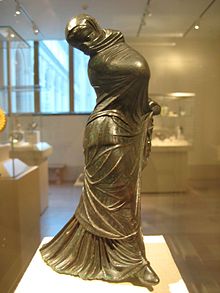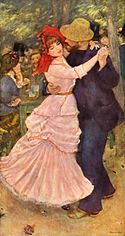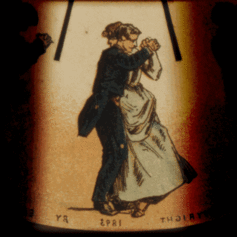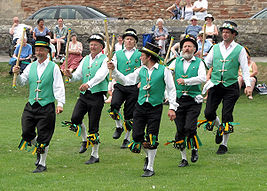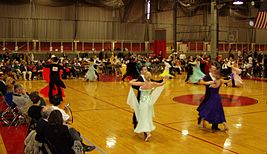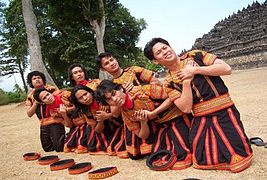
Dance
Background to the schools Wikipedia
SOS believes education gives a better chance in life to children in the developing world too. All children available for child sponsorship from SOS Children are looked after in a family home by the charity. Read more...
| Dance | |
|---|---|
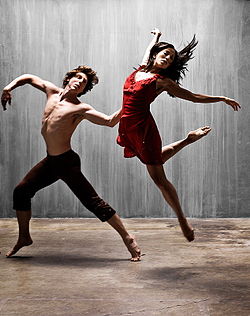 Modern dance |
|
| Originating culture | various |
| Originating era | Antiquity |
Dance is a type of art that generally involves movement of the body, often rhythmic and to music. It is performed in many cultures as a form of emotional expression, social interaction, or exercise, in a spiritual or performance setting, and is sometimes used to express ideas or tell a story. Dance may also be regarded as a form of nonverbal communication between humans or other animals, as in bee dances and behaviour patterns such as a mating dances.
Definitions of what constitutes dance can depend on social and cultural norms and aesthetic, artistic and moral sensibilities. Definitions may range from functional movement (such as folk dance) to virtuoso techniques such as ballet. Martial arts kata are often compared to dances, and sports such as gymnastics, figure skating and synchronized swimming are generally thought to incorporate dance. In some cases, the motion of ordinarily inanimate objects may be described as dance (the leaves danced in the wind).
There are many styles and genres of dance. African dance is interpretative. Ballet, ballroom and tango are classical dance styles. Square dance and electric slide are forms of step dance, and breakdancing is a type of street dance. Dance can be participatory, social, or performed for an audience. It can also be ceremonial, competitive or erotic. Dance movements may be without significance in themselves, as in ballet or European folk dance, or have a gestural vocabulary or symbolic meaning as in some Asian dances.
Choreography is the art of creating dances. The person who creates (i.e., choreographs) a dance is known as the choreographer.
Origins and history
Dance does not leave behind clearly identifiable physical artifacts such as stone tools, hunting implements or cave paintings. It is not possible to say when dance became part of human culture.
Joseph Jordania recently suggested that dance, together with rhythmic music and body painting, was designed by the forces of natural selection at the early stage of hominid evolution as a potent tool to put groups of human ancestors in a battle trance, a specific altered state of consciousness. In this state hominids were losing their individual identity and were acquiring collective identity. Jonathan Pieslak's research shows that some contemporary military units use loud group singing and dancing in order to prepare themselves for the dangerous combat missions. According to Jordania, this trance-inducing ability of dance comes from human evolutionary past and includes as well a phenomenon of military drill which is also based on shared rhythmic and monotonous group activity.
Dance has certainly been an important part of ceremony, rituals, celebrations and entertainment since before the birth of the earliest human civilizations. Archeology delivers traces of dance from prehistoric times such as the 9,000 year old Rock Shelters of Bhimbetka paintings in India and Egyptian tomb paintings depicting dancing figures from c. 3300 BC.
One of the earliest structured uses of dances may have been in the performance and in the telling of myths. It was also sometimes used to show feelings for one of the opposite gender. It is also linked to the origin of "love making." Before the production of written languages, dance was one of the methods of passing these stories down from generation to generation.
Another early use of dance may have been as a precursor to ecstatic trance states in healing rituals. Dance is still used for this purpose by many cultures from the Brazilian rainforest to the Kalahari Desert.
Sri Lankan dances goes back to the mythological times of aboriginal yingyang twins and " yakkas" (devils). According to a Sinhalese legend, Kandyan dances originated 250 years ago, from a magic ritual that broke the spell on a bewitched king. Many contemporary dance forms can be traced back to historical, traditional, ceremonial, and ethnic dance.
Classification and genres
Partner Dancing in Art
Dance categories by number of interacting dancers are mainly solo dance, partner dance and group dance. Dance is performed for various purposes like ceremonial dance, erotic dance, performance dance, social dance etc.
Dancing and music
Many early forms of music and dance were created and performed together. This paired development has continued through the ages with dance/music forms such as: jig, waltz, tango, disco, salsa, electronica and hip-hop. Some musical genres have a parallel dance form such as baroque music and baroque dance; others, such as classical music and classical ballet, developed separately.
Although dance is often accompanied by music, it can also be presented independently or provide its own accompaniment ( tap dance). Dance presented with music may or may not be performed in time to the music depending on the style of dance. Dance performed without music is said to be danced to its own rhythm.
Ballroom dancing is a dance art form which combines athletic fitness with artistically skillful dance steps.
Dance studies and techniques
In the early 1920s, dance studies (dance practice, critical theory, Musical analysis and history) began to be considered as an academic discipline. Today these studies are an integral part of many universities' arts and humanities programs. By the late 20th century the recognition of practical knowledge as equal to academic knowledge led to the emergence of practice research and practice as research. A large range of dance courses are available including:
- Professional practice: performance and technical skills
- Practice research: choreography and performance
- Ethnochoreology, encompassing the dance-related aspects of: anthropology, cultural studies, gender studies, area studies, postcolonial theory, ethnography, etc.
- Dance therapy, or dance-movement therapy
- Dance and technology: new media and performance technologies
- Laban Movement Analysis and somatic studies
Academic degrees are available from BA (Hons) to PhD and other postdoctoral fellowships, with some dance scholars taking up their studies as mature students after a professional dance career.
Dance competitions
A dance competition is an organized event in which contestants perform dances before a judge or judges for awards, and in some cases, monetary prizes. There are several major types of dance competitions, distinguished primarily by the style or styles of dances performed. Major types of dance competitions include:
- Competitive dance, in which a variety of theatre dance styles such as: acro, ballet, jazz, hip-hop, lyrical, and tap, are permitted.
- Open competitions, that permit a wide variety of dance styles. A popular example of this is the TV program So You Think You Can Dance.
- Dancesport, which is focused exclusively on ballroom and latin dance. Popular examples of this are TV programs Dancing with the Stars and Strictly Come Dancing.
- Single-style competitions, such as; highland dance, dance team, and Irish dance, that only permit a single dance style.
Today, there are various dances and dance show competitions on television and the Internet.
Occupations
There are several careers connected with dancing: Dancer, dance teacher, dance sport coach, dance therapist and choreographer.
- Dancer
Dance training differs depending on the dance form. There are university programs and schools associated with professional dance companies for specialised training in classical dance (e.g. Ballet) and modern dance. There are also smaller, privately owned dance studios where students may train in a variety of dance forms including competitive dance forms (e.g. Latin dance, ballroom dance, etc.) as well as ethnic/traditional dance forms.
Professional dancers are usually employed on contract or for particular performances/productions. The professional life of a dancer is generally one of constantly changing work situations, strong competition pressure and low pay. Professional dancers often need to supplement their income, either in dance related roles (e.g., dance teaching, dance sport coaches, yoga) or Pilates instruction to achieve financial stability.
In the U.S. many professional dancers are members of unions such as the American Guild of Musical Artists, the Screen Actors Guild and Actors' Equity Association. The unions help determine working conditions and minimum salaries for their members.
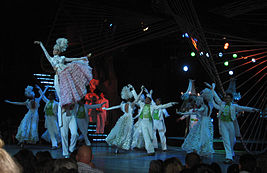
- Dance teachers
Dance teacher and operators of dance schools rely on reputation and marketing. For dance forms without an association structure such as Salsa or Tango Argentino they may not have formal training. Most dance teachers are self-employed.
- Dancesport coaches
Dancesport coaches are tournament dancers or former dancesports people, and may be recognised by a dance sport federation.
- Choreographer
Choreographers are generally university trained and are typically employed for particular projects or, more rarely may work on contract as the resident choreographer for a specific dance company. A choreographic work is protected intellectual property. Dancers may undertake their own choreography.
By ethnicity or region
India
During the first millennium BCE in India, many texts were composed which attempted to codify aspects of daily life. In the matter of dance, Bharata Muni's Natyashastra (literally "the text of dramaturgy") is one of the earlier texts. Though the main theme of Natyashastra deals with drama, dance is also widely featured, and indeed the two concepts have ever since been linked in Indian culture. The text elaborates various hand-gestures or mudras and classifies movements of the various limbs of the body, gait, and so on. The Natyashastra categorised dance into four groups and into four regional varieties, naming the groups: secular, ritual, abstract, and, interpretive. However, concepts of regional geography has altered and so have regional varieties of Indian dances. Dances like "Odra Magadhi", which after decades long debate, has been traced to present day Mithila, Odisha region's dance form of Odissi (Orissi), indicate influence of dances in cultural interactions between different regions.
From these beginnings rose the various classical styles which are recognised today. Therefore, all Indian classical dances are to varying degrees rooted in the Natyashastra and therefore share common features: for example, the mudras, some body positions, and the inclusion of dramatic or expressive acting or abhinaya. The Indian classical music tradition provides the accompaniment for the dance, and as percussion is such an integral part of the tradition, the dancers of nearly all the styles wear bells around their ankles to counterpoint and complement the percussion.
Bhangra in the Punjab
The Punjab area overlapping India and Pakistan is the place of origin of Bhangra. It is widely known both as a style of music and a dance. It is mostly related to ancient harvest celebrations, love, patriotism or social issues. Its music is coordinated by a musical instrument called the 'Dhol'. Bhangra is not just music but a dance, a celebration of the harvest where people beat the dhol (drum), sing Boliyaan (lyrics) and dance.It developed further with the Vaisakhi festival of the Sikhs.
Dances of Sri Lanka
The devil dances of Sri Lanka or "yakun natima" are a carefully crafted ritual with a history reaching far back into Sri Lanka's pre-Buddhist past. It combines ancient " Ayurvedic" concepts of disease causation with psychological manipulation. The dance combines many aspects including Sinhalese cosmology, the dances also has an impact on the classical dances of Sri Lanka.
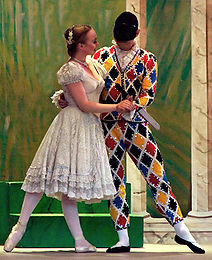
In Europe and North America
Concert (or performance) dance
Ballet
Ballet developed first in Italy and then in France from lavish court spectacles that combined music, drama, poetry, song, costumes and dance. Members of the court nobility took part as performers. During the reign of Louis XIV, himself a dancer, dance became more codified. Professional dancers began to take the place of court amateurs, and ballet masters were licensed by the French government. The first ballet dance academy was the Académie Royale de Danse (Royal Dance Academy), opened in Paris in 1661. Shortly thereafter, the first institutionalized ballet troupe, associated with the Academy, was formed; this troupe began as an all-male ensemble but by 1681 opened to include women as well.
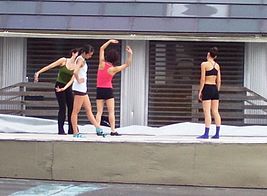
20th-century concert dance
At the beginning of the 20th century, there was an explosion of innovation in dance style characterized by an exploration of freer technique. Early pioneers of what became known as modern dance include Loie Fuller, Isadora Duncan, Mary Wigman and Ruth St. Denis. The relationship of music to dance serves as the basis for Eurhythmics, devised by Emile Jaques-Dalcroze, which was influential to the development of Modern dance and modern ballet through artists such as Marie Rambert. Eurythmy, developed by Rudolf Steiner and Marie Steiner-von Sivers, combines formal elements reminiscent of traditional dance with the new freer style, and introduced a complex new vocabulary to dance. In the 1920s, important founders of the new style such as Martha Graham and Doris Humphrey began their work. Since this time, a wide variety of dance styles have been developed; see Modern dance.
The influence of African American dance
African American dances are those dances which have developed within African American communities in everyday spaces, rather than in dance studios, schools or companies and its derivatives, tap dance, disco, jazz dance, swing dance, hip hop dance and breakdance. Other dances, such as the lindy hop with its relationship to rock and roll music and rock and roll dance have also had a global influence.
| Performing arts | |
|---|---|
|
Major forms
|
|
|
Minor forms
|
|
|
Circus skills · Magic · Mime · Puppetry · Speech |
|
|
Genres
|
|
|
Drama · Tragedy · Comedy · Tragicomedy · Romance · Satire · Epic · Lyric |
|
